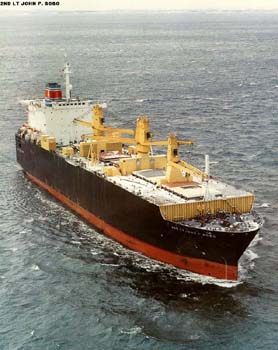

|
The MPS Program at Quincy Shipbuilding"Quincybuilt...The best thing you can say about a ship" |

The ships were prepositioned in key spots around the world, close to potential trouble spots. This prepositioning eliminated lengthy trans-oceanic shipping delays, greatly improving the Marines' ability to respond to emerging crises or conflicts. The five Quincy ships were the first purpose-built prepositioning ships in US service. Together with eight similar ships, converted from commercial vessels in 1984-1985, they form a key part of today's Marine Corps force. Since the introduction of the first 13 Maritime Prepositioning Ships, the prepositioning concept has grown rapidly - today the prepositioning force includes Army, Air Force, Navy and Marine Corps equipment, and continues to grow.
An unusual aspect of the MPS program is the ownership of the vessels - they are not owned by the Navy at all. The ships were designed and built by General Dynamics Quincy Shipbuilding Division, and are owned and operated by General Dynamics' American Overseas Marine (AMSEA) subsidiary under a 25 year charter. Through this arrangment the Navy avoids all up-front design, development, and construction costs, and there are no maintenance, overhaul, or repair costs. Instead, the Navy (through the Military Sealift Command) pays only a single annual charter fee.
Sadly, the MPS program marked the end of an era at the Quincy shipyard. When MPS construction was completed there were no orders on the books, and few prospects for additional business in the future. With the delivery of the last MPS, SGT William R. Button, in May of 1986, the shipyard began shutting down. In 1987 the Quincy Shipbuilding Division officially ceased operations, concluding 87 years of shipbuilding at the Quincy site. After 107 years, the shipbuilding business founded by Thomas Augustus Watson was at an end.
|
The MPS Program at Quincy |
|
![[THUMBNAIL]](mps35a.jpg)
|
The MPS Concept, Capabilities, & Characteristics The unique role and mission of the Maritime Prepositioning Ships, and the ships' characteristics and sealift capabilities. (4 photos) |
![[THUMBNAIL]](mps06a.jpg)
|
MPS Construction Follow the construction of the first Quincy MPS, from the plate yard through the fabrication shops, and to the building slip. Unique, detailed photos showing a modern shipbuilding process in action. (22 photos) |
![[THUMBNAIL]](mps36a.jpg)
|
MPS Completion, Trials, & Delivery The final stages of ship construction and fitting out, a look at the various Marine Corps vehicles carried as cargo, and photos of the first Quincy MPS at sea on her delivery voyage. (14 photos) |

|
The Quincybuilt Maritime Prepositioning Ships Click on the image for a larger version, or on the words "Jumbo Image" for an extra-large (approx. 1500x1200 pixel) version. |
|
![[THUMBNAIL]](mps45a.jpg) [Jumbo Image]
|
M/V 2nd LT John P. Bobo (T-AK 3008), Quincy Hull #61, Delivered 14 February 1985. |
![[THUMBNAIL]](mps46a.jpg) |
M/V PFC Dewayne T. Williams (T-AK 3009), Quincy Hull 62, Delivered 6 June 1985. |
![[THUMBNAIL]](mps47a.jpg) [Jumbo Image]
|
M/V 1st LT Baldomero Lopez (T-AK 3010), Quincy Hull 63, Delivered 20 November 1985. |
![[THUMBNAIL]](mps48a.jpg) |
M/V 1st LT Jack Lummus (T-AK 3011), Quincy Hull 64, Delivered 6 March 1986. |
![[THUMBNAIL]](mps49a.jpg) |
M/V SGT William R. Button (T-AK 3012), Quincy Hull 65, Delivered 22 May 1986. The last Quincybuilt ship. |

| Haze Gray & Underway | |||||
| Naval History Info Center | US Warship Histories - DANFS | World Navies Today | |||
| Photo Galleries | Shipbuilding | Navsource Photos | |||
| HG&UW Home | Contact Info | About the Site | Web Links | FAQs | Back |
Copyright © 2003, Andrew Toppan. All Rights Reserved.
Reproduction, reuse, or distribution without permission is prohibited.